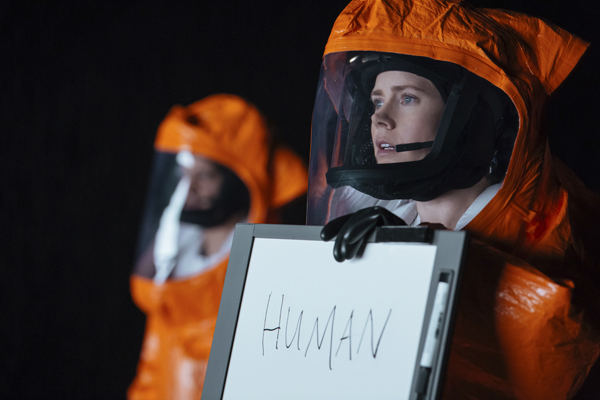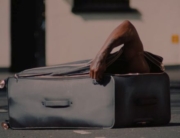![]() Talk about sending mixed signals. Denis Villeneuve’s multilayered, amorphous Arrival begins with an alien invasion. A total of 12 spacecraft have landed in locations all over the world, including China, Pakistan, Russia, and remote Montana, where a black, flattened, egglike object about the length of a skyscraper hovers above the grassy fields. But what begins as a sci-fi summit of the worlds eventually takes on the form of a different type of movie.
Talk about sending mixed signals. Denis Villeneuve’s multilayered, amorphous Arrival begins with an alien invasion. A total of 12 spacecraft have landed in locations all over the world, including China, Pakistan, Russia, and remote Montana, where a black, flattened, egglike object about the length of a skyscraper hovers above the grassy fields. But what begins as a sci-fi summit of the worlds eventually takes on the form of a different type of movie.
While giving a lecture to a half-empty hall, linguistics professor Louise Banks (Amy Adams) loses the attention of her undergrads, who, after checking their smartphones, pack up and leave class upon the breaking news of outer space visitors. A state of emergency is declared, and needless to say school is canceled.
While she’s alone in her office, Army Colonel Weber (Forest Whitaker) pays her a surprise visit and plays for her an audio recording of sounds emitted from the extraterrestrial newcomers. She can’t make out the meaning of the sounds without face-to-visage time, so with a little coaxing, Louise joins an assembling team of scientists, who will be the first to make contact with whatever has landed upon American soil. Weber returns to pick her up in the most dramatic fashion possible: a military helicopter that swoops down and lands in front of her bucolic home on Puget Sound, whisking her off in the middle of the night.
Depending on one’s outlook, the spaceship looks imposing but harmless, or its shape could bring back nightmares of the eggs in the original Alien that were full of slithery surprises. However, one indication that this space opera is not going to become too special effects-driven or action-oriented is the declaration by Louise’s new colleague, physicist Dr. Ian Connelly (Jeremy Renner), that “science is the basis of civilization,” and thus they have to man the frontline of the first intergalactic encounter.
The script takes into serious consideration the question: What would you say to a space alien? What are the protocols or potential misinterpretations, and the resulting fallout of either? In the first attempt at communication, Louise and her teammates gear up in spacesuits, lest the atmosphere within the foreign vessel suffocates them. Viewers get plenty of bang for their buck when she and her team float up in zero gravity into the spacecraft and the unknown, where the aliens appear out of the bowels of the ship. They look like a cross between artist Louise Bourgeois’s giant spider sculptures and octopuses walking on seven tentacles, the tips of which look like starfish. Only a glass wall separates them from the human inquisitors.
While much of the world panics with visions of an apocalypse, Louise remains focused, attempting to solve the mystery of what the aliens are trying to communicate through their cryptic, circular symbols, formed by vaporous black ink, and their overall intentions. Ideas, namely linguistic concepts, are the real stars here, and as such, Villeneuve has produced a film that fans of the old Star Trek series have been craving. It brings back the wonderment and speculation of the 1960s series in a thoughtful manner (which none of the movie iterations of the show have achieved, except for maybe Star Trek IV: The Voyage Home). Because Louise approaches language as a mathematician, the plot boldly goes wonky.
With its trappings, this is a woman’s picture dressed up in sci-fi finery, though not in the sense of being a stereotypical sentimental tearjerker (which is not to say it isn’t moving). Its core character exists apart from men, professionally or otherwise. But given Louise’s intellectual acumen, she stands apart from anyone else, too. (It’s not coincidental that the colonel finds her alone in her office when everyone else has hightailed it.)
The only approval Louise seeks is regarding her theories about the aliens. Any flirtation she has with the rakish Ian is kept to a minimum, as they have more urgent undertakings to consider, such as preventing an unnecessary war between trigger-happy countries and the aliens. From the get-go, the script takes it for granted that Louise is not only strong-willed and independent but accessible as well. Perhaps never before has Adams given such an empathetic performance.
Louise’s voice-over permeates the entire film as she narrates the story, which doubles as a love letter or a bedtime story to her fatally ill 12-year-old daughter, Hannah. Moments from their lives flash on screen as part of Louise’s stream of consciousness. Though the film is based on the 1998 short story, “Story of Your Life,” by Ted Chiang, the dying daughter subplot might come across as a direct retread from Gravity, in which Sandra Bullock played a mourning mother in outer space. But that works to Villeneuve‘s advantage, as he takes the familiar and turns it on its head. As it turns out, this subplot is not simply shorthand for Louise’s background; it serves as the foundation for the entire story, the tone of which is maternal through and through. Science fiction and the woman’s picture rarely collide, but here Villeneuve proves that they don’t have to be exclusive from the other.
Though seemingly straightforward, Arrival is also a real brain twister. But unlike Inception or Interstellar, all the pieces to the narrative puzzle fit into place with having to be jammed in. Even the music by Johann Johannsson is another code to decipher, a cacophony of woodwinds and bass notes with inchoate vocals, which sounds like a chorus from Babel set to an atonal score. It all begs to be experienced again.

















smart review. not just because i agree with it, but…well because i agree with it.
i think this is one of the smarter sci-fi movies i have seen in some time. if you are going to tackle this topic, do it with profound understanding